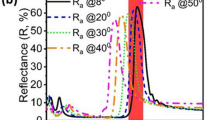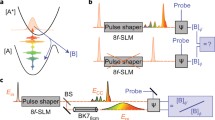Abstract
Polymer films made with photosensitive chromophore protein bacteriorhodopsin (BR) from the extreme halophile Halobacterium salinarium as well as films made with BR derivatives exhibit a nonlinear photoinduced anisotropy. Two different methods can be used to induce anisotropy in polymer BR films. The first method is based on the anisotropic properties of the initial form of the photocycle, BR570 (B-type anisotropy). Another method is based on the anisotropic properties of the longest-lived photocycle intermediate M412 (M-type anisotropy). CW gas lasers were employed to induce a reversible anisotropy in polymer BR films. Nonlinear photoinduced anisotropy is discussed in the context of a model for the anisotropic photoselection of BR molecules under linearly polarized light. A comparison of the experimental dependencies of nonlinear photoinduced anisotropy on laser intensity with similar calculated dependencies enables one to determine the molecular dichroism of BR and its derivatives not only for the initial form of the photocycle, B but also for the longest-lived intermediate M. Here we present the data showing the correlation between the laser induced nonlinear anisotropic properties and chromophore/protein interactions in BR. The effect of polymer binder on the nonlinear photoanisotropic properties of polymer BR films is also described.
Similar content being viewed by others
References
Birge, R.: Nature of the primary photochemical events in rhodopsin and bacteriorhodopsin, Biochimica et Biophysica Acta 1016 (1990), 293–327.
Miyasaka, T.: Design of intelligent optical sensors with organized bacteriorhodopsin films, Jpn. J. Appl. Phys. 34 (1995), 3920–3924.
Kramer, M., Tompkin, W. and Boyd, R.: Nonlinear optical interactions in fluorescein-doped boric acid glass, Phys. Rev. A 34 (1986), No. 3, 2026–2031.
Korchemskaya, E., Soskin, M., Stepanchikov, D., Druzhko, A. and Dyukova, T.: Nonlinear polarization interaction in bacteriorhodopsin films with anisotropically saturating absorption, SPIE Proc. 2802 (1995), 200–210.
Burykin, N., Korchemskaya, E., Soskin, M., et al.: Photoinduced anisotropy in Biochrom films, Opt. Commun. 54 (1985), No. 2, 68–71.
Nagle, J., Bhattacharjee, S., Parodi, L. and Lozier, R.: Effect of photoselection upon saturation and the dichroic ratio in flash experiments upon effectively immobilized systems, Photochem. Photobiol. 38 (1983), 331–339.
Dyukova, T. and Lukashev, E.: Dehydration effects on D96N bacteriorhodopsin films, Thin Solid Films 283 (1996), 1–4.
Dyukova, T., Robertson, B. and Weetall, H.: Optical and electrical characterization of bacteriorhodopsin films, BioSystems 41 (1997), 91–98.
Druzhko, A. and Weetall, H.: Photoinduced transformations of wild type and D96N mutant 4-keto-bacteriorhodopsin gelatin films, Thin Solid Films 293 (1997), No. 1–2, 281–284.
Dyukova, T., Vsevolodov, N. and Chekulaeva, L.: Dehydration-induced changes in photochemical activity of bacteriorhodopsin in polymer matrix, Biofizika 30 (1985), No. 4, 613–616.
Korchemskaya, E. and Soskin, M.: Application of anisotropically-saturating nonlinearity of polymer films based on bacteriorhodopsin for spatially-intensity filtration, Optical Memory and Neural Networks 4 (1995), No. 1, 53–59.
Imam, H., Lindvold, L. and Ramanujam, P.: Photoanisotropic incoherent-to-coherent converter using a bacteriorhodopsin thin film, Optics Letters 20 (1995), 225–227.
Hampp N. Brauchle C.and Oesterhelt D. Bacteriorhodopsin wildtype and variant aspartate-96'asparagine as reversible holographic media Biophys.J. 58 1990, 83–93
Sperling, W. and Rafferty, C.N.: Relationship between absorption spectrum and molecular conformations of 11-cis-retinal, Nature 224 (1969), 591–594.
Balashov, S.P. and Litvin, F.F.: Photochemical transformations of bacteriorhodopsin, Biofizika 26 (1981), No. 3, 557–570.
Braslavsky, S.: Time-resolved photothermal studies with biological photoreceptors, The Spectrum, 1994, 10–16.
Tuzi, S., Yamaguchi, S., Naito, A., Needleman, R., Lanyi, J. and Saito, H.: Conformation and dynamics of [3-13C] Ala-labeled bacteriorhodopsin and bacterioopsin, induced by interaction with retinal and its analogs, as studied by 13C nuclear magnetic resonance, Biochemistry 35 (1996), No. 23, 7520–7527.
Author information
Authors and Affiliations
Rights and permissions
About this article
Cite this article
Korchemskaya, E., Stepanchikov, D., Druzhko, A. et al. Mechanism of Nonlinear Photoinduced Anisotropy in Bacteriorhodopsin and its Derivatives. Journal of Biological Physics 24, 201–215 (1999). https://doi.org/10.1023/A:1005135209028
Issue Date:
DOI: https://doi.org/10.1023/A:1005135209028




